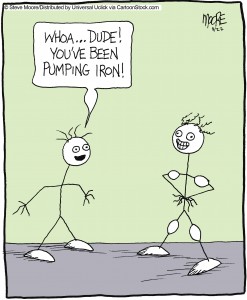There are some days when growing older simply feels like a big old pain in the butt. Despite the wrinkles, grey hairs and even sags in places we didn’t know could sag, there are important steps you can take to keep some parts of the aging process at bay, such as a loss of muscle. And while many of us stay strapping until about the age of 40, after that time there is evidently a progressive decline in muscle, leading to eventual weakness, slowing of movement and even disability. Have you ever observed an elderly person trying to rise from a chair or climb the stairs? It’s tough to watch, right?
Fortunately, researchers say that there are a few steps that you can take to slow the process and protect what you have, even if you are past the age of 40. Mind you, the rate at which muscles age can vary widely between individuals and genetics do play a role. In fact, genetics may be responsible for more than half of muscle variance and this variance is evidently is driven by your mother’s genes; not only is her longevity predictive of how long you might live but it also affects muscle size and strength as you grow older.
Not surprisingly, hormones also play a role. Darn, that estrogen keeps rearing her ugly head! Indeed, it appears that not only do declines in estrogen impact skeletal muscle structure but also function, robbing women of the much needed ability to keep muscles tense when they need to be.
Still, researchers say that there are still opportunities to modify the trend.
- Nutrition is important. You’ve heard the caloric restriction can prolong life, right? But it’s not without risk and researchers say that lower food intake can lead to reduced nutrient intake, which actually boosts systemic inflammation, a culprit in muscle loss as well as a host of other illnesses. But supplementing with antioxidants, incorporating omega-3s into the diet and focusing on amino acid, leucine rich foods, such as cottage cheese, egg whites, low-fat beef, fish, chicken, lentils and soybeans (all of which provide ample protein) may hep to reduce inflammation, improve muscle function (namely the functioning of muscle fibers) and boost muscle size.
- Physical activity is key! Exercise actually reduces low-grade systemic inflammation that plagues our bodies as we age. And, it directly benefits skeletal muscle by helping to maintain the function of muscle fibers, attenuate the loss of muscle units and help reduce the loss of cells that are important for muscle regeneration. Regular exercise may also help the body to oxygenate muscles and tissues, another factor that declines with aging.
Listen up! Keeping muscles strong and healthy doesn’t mean that you need ripped. However, what it does mean is that you need to get it right. Exercise your brain on this one, make sure that you are getting proper nutrition and move your body. And start now; not when you are sitting in that chair struggling to get up.








On this topic, I have two books to recommend: The Paleo Diet, about the foods our bodies have evolved to eat over millions of years (not the last few thousand) and Younger Next Year, which is a sensational (and funny and scientific) tome on the benefits of exercise after 40.
@mamieduff Mamie – certain aspects of The Paleo Diet have proven to be downright dangerous for women of a ‘certain age.’http://flashfree.me/2012/06/29/have-a-heart-low-carb-high-protein-diets/. Be careful!